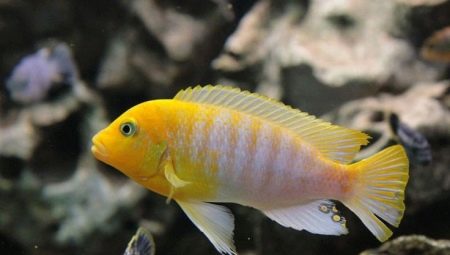Pseudotrophies are endemic to Lake Malawi in East Africa. Their unique appearance is so loved by aquarists around the world that now they can often be found in home aquariums. Consider what makes pseudotrophies interesting, what are their varieties and how to properly care for them.
View description
Pseudotrophies are called fish belonging to the family of cichlids (cichlids). They belong to a subgroup called "Mbuna", which translates as "inhabitant of the rocks." This phrase gives an accurate description of the lifestyle of the pseudotrophaeus, as they prefer to live near the coast, among the underwater rocks.
The appearance of a typical representative of these fish: high body, flattened on the sides, large expressive eyes, clearly defined lips, two-teeth, resembling a grater. Color and size vary by breed.
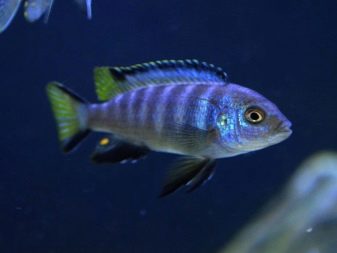
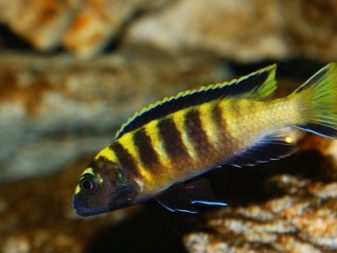
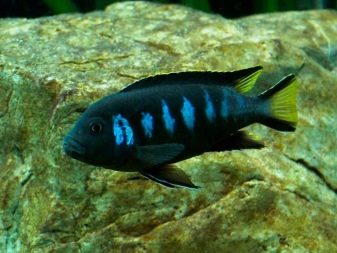

Varieties
And now we will get to know more closely these amazing fish and learn about each species a little bit.
- Zebra. It occurs more often than others. As the name implies, the color of these pseudotrophies is striped, and the stripes are usually blue-blue or brownish in color. However, among zebras there are also monotonously colored representatives: blue, scarlet, canary yellow, snow-white. Females instead of stripes have spots or may be monochrome. The size of this variety does not exceed 10-12 cm.
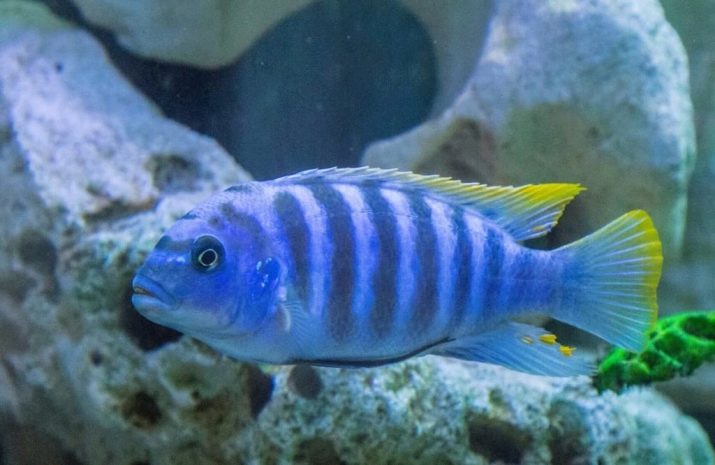
- Fuscoides. The second name is brown pseudotrophy. It is slightly smaller than the previous variety - up to 10 cm. However, it is not inferior in brightness: Fuscoides are painted in bright yellow, brown-purple, chocolate and lemon tones.
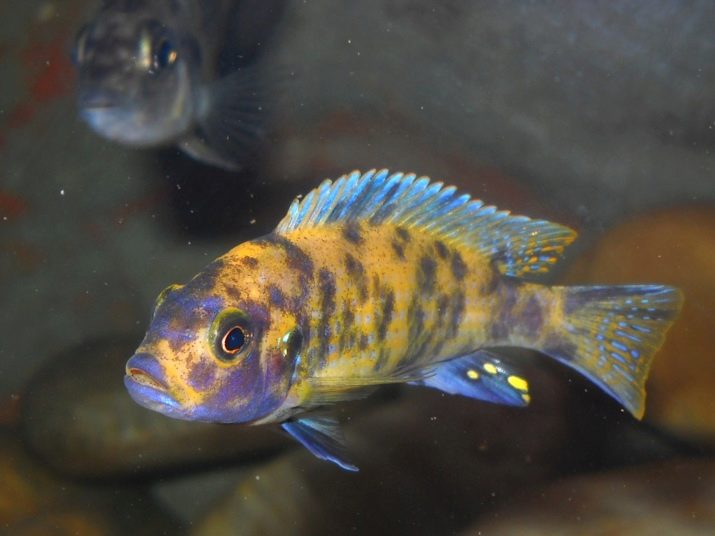
- Lombardo It has a slightly elongated body, slightly flattened on the sides, the back is high.The male is colored yellow, ranging from golden to brownish. Some representatives on the sides show dim bands. Unpaired fins have a bluish tint, small yellowish spots resembling eggs are visible on the anal, there is a white border on the dorsal. Females and young animals are colored differently: light blue with black stripes on the sides. The size of the Lombardo pseudotrophyus is 13-15 cm.
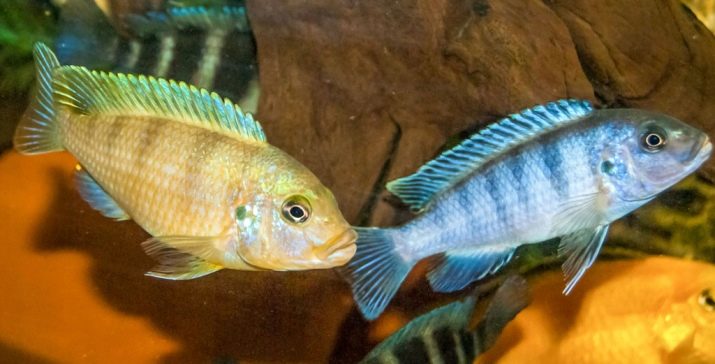
- Elongatus. It has several subspecies: mpanga, chaylozi, chevery, ornatus, neon spot. Depending on the accessory, the color also varies, but almost all have dark stripes across the body. It is difficult to distinguish a male from a female, except in size and behavior: males are larger and more aggressive. In captivity, male elongatus reaches a maximum size of 14 cm, females - 9-10 cm.
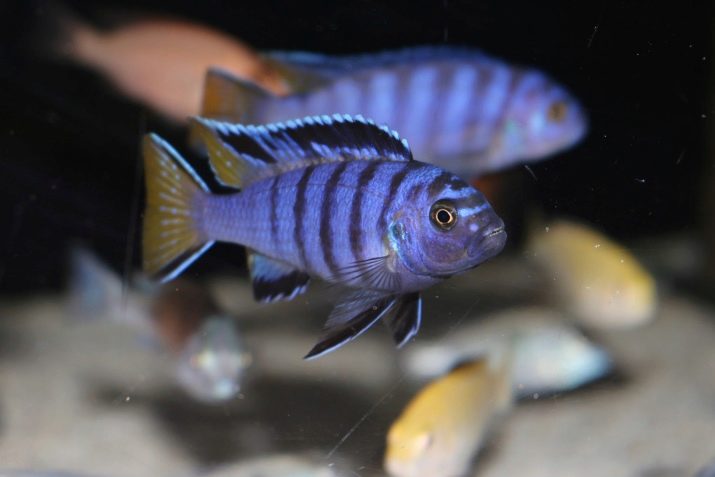
- Saulosi. But this variety is characterized by obvious inter-gender differences: the male is painted bright blue with wide black stripes on the sides, the female is canary yellow, with pale stripes, and sometimes they are not at all. Interestingly, all fry are yellow at birth, and when they grow up, only the main males turn blue. Those that are weaker remain similar to females. The size of the pseudotrophheus saulosi is 9-10 cm.
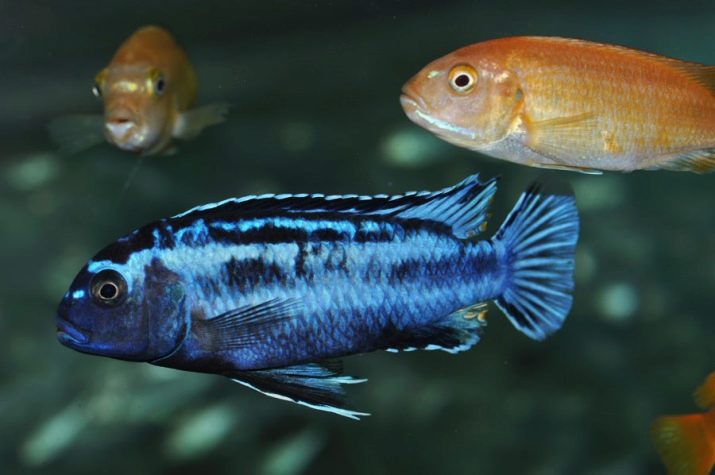
- Acei. Subspecies: Itungi, Luval, Ngara, Dvangva, Mzuli. The color varies depending on the variety, it is bright blue, beige, black, there is a yellow tint on the fins. In the wild, this fish grows up to 10 cm, while in the aquarium it can "extort" up to 17-18. But despite such impressive parameters, the fish is quite peaceful, calm, gets along well with representatives of its own and of another species. Acei live in packs of 5 individuals in a group.
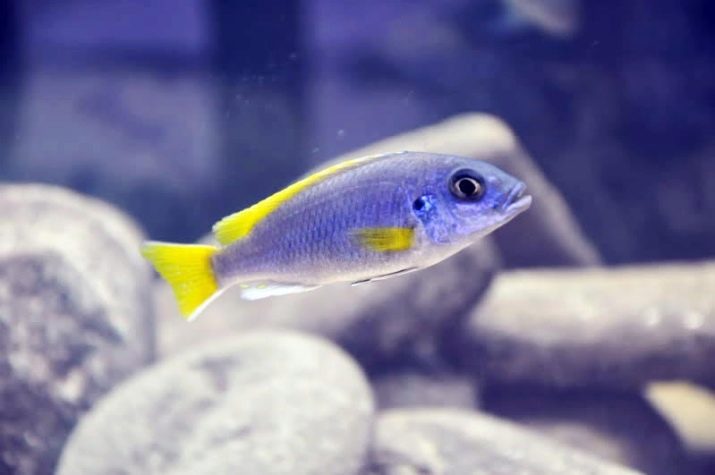
- Sokolova (Sokolofi, Pindani). Bright and beautiful fish. Representatives of both sexes flaunt a sky blue color with a lilac shade. On the fins there is an ink-blue border. Pindani have one feature: when they get scared, they begin to become covered with purple spots.
Gender differences are implicit: “men” have more developed fins, and they have a larger size - 12 cm, “ladies” - only 8-10.
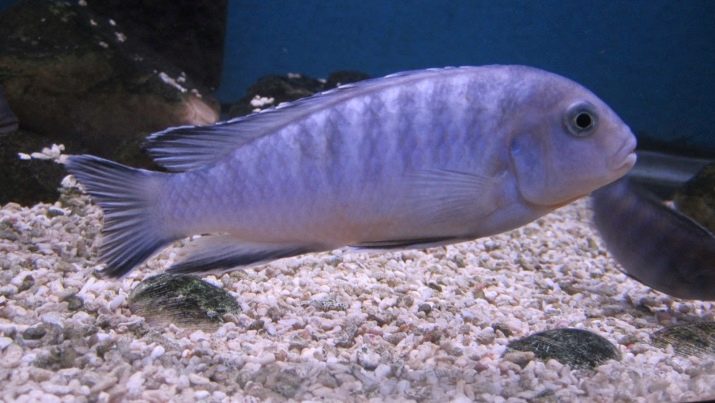
An artificially deduced version of Sokolov's pseudotrophyus is the Snow Prince. The fish received such a name for its snow-white color and smooth movements. "Prince" is an albino, in the wild is not found. The eyes of such individuals are always bright red.
- Flavus. A handsome man reminiscent of either a tiger or a bee. Black transverse stripes pass through a bright yellow body. Females are colored slightly paler than males, young growth is gray-yellow. In captivity, flavus grow to 8-9 cm.
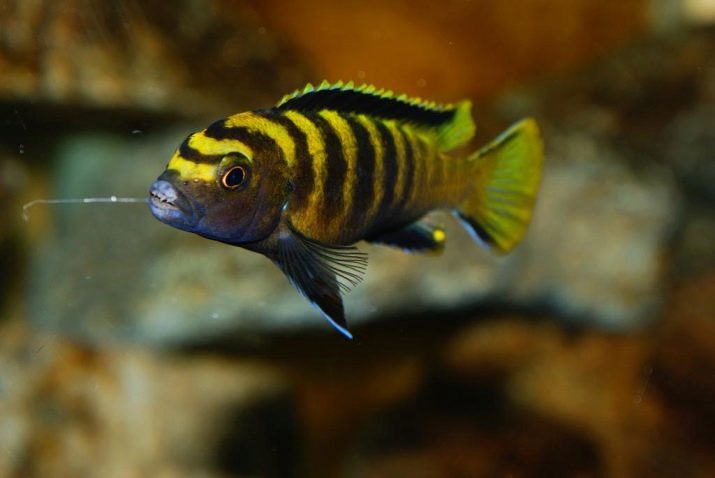
- Polit. It has characteristic gender differences: males are colored in silver-pearl color with a black muzzle, while females are golden-beige, not very noticeable.
An interesting feature: when a danger arises, the male polites immediately “repaint” and become one-on-one similar to females. The maximum size of the watered in the aquarium is 8-10 cm.
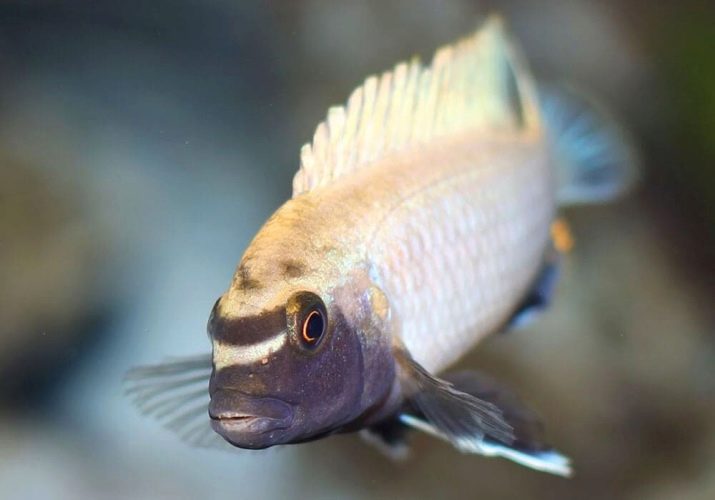
- Greshaki. Another variety where it is impossible to confuse the male and female. Males are quite bright, have a bluish-lilac body with bright orange dorsal and caudal fins. Females are modestly colored - brownish-gray, brown stripes are slightly noticeable on the sides. The size of the fish is 13-14 cm.
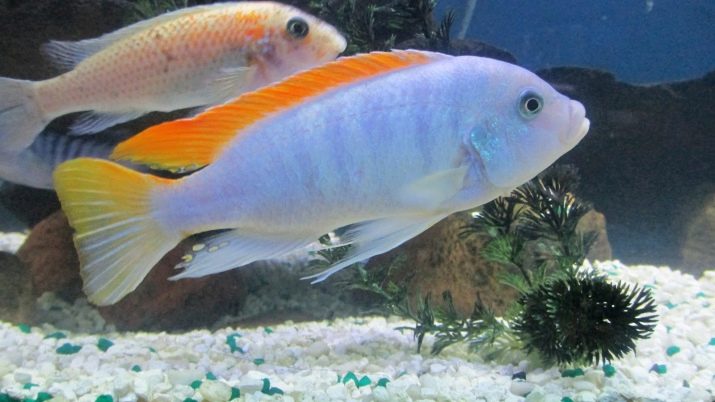
- Interruptus. Beautiful cichlid. The color of the males is ink-blue, bright blue spots are scattered on the top of the back and on the muzzle, the border on the tail and fins is white. The females are golden yellow, solid. Fries are born beige.
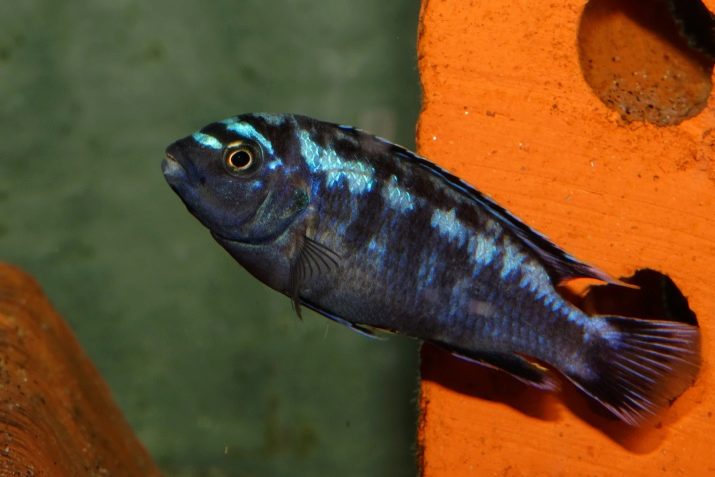
- Crabro. Also referred to as bumblebee cichlid or chameleon cichlid. Crabro received these two names for two features: females and young animals have a black and yellow striped color and the fact that this pseudotrophy has the ability to change its color. Such mimicry is very useful for a fish in the wild - the fact is that it is adjacent to a large catpango catfish, which “allows” it to eat parasites that attack its skin.The catfish gets used to the yellow-black color of crabro and does not recognize it in the dark color in which it “dresses up” to eat the eggs of this catfish itself! Here is such a tricky creation - pseudotrophy crabro.
By the way, males of this species initially have a dark color with small light stripes on the back. In an aquarium, a fish can grow up to 10 cm.
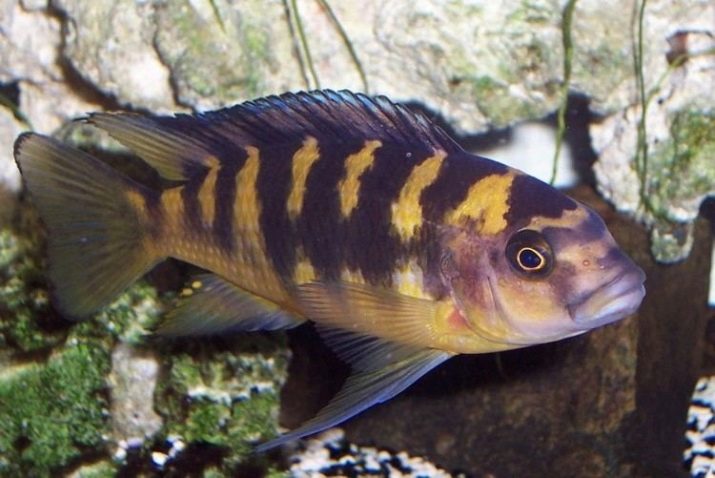
- Aurora. Very bright and colorful cichlid. Her scales have a mauve color with a touch of turquoise. The fins and abdomen are yellow. The size of the individual is 10-12 cm.
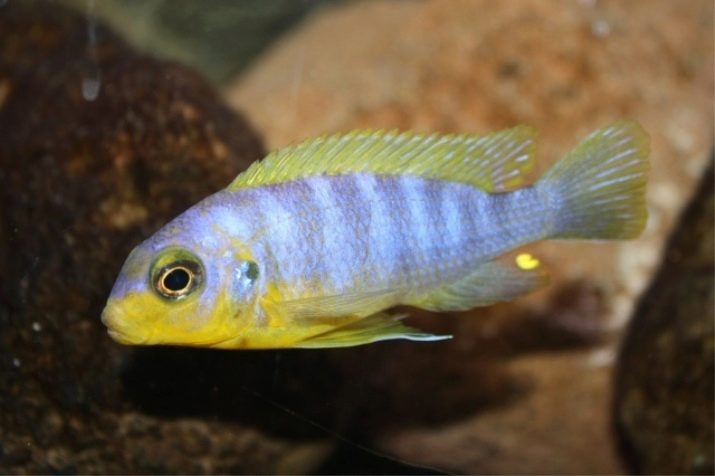
- Livingstoni. Quite a modest representative among the pseudotrophies. Its color is yellow-gray, yellow-blue individuals are found. On the fins of males there is a black and white edging. Livingstoni size - 6-8 cm, maximum 10.
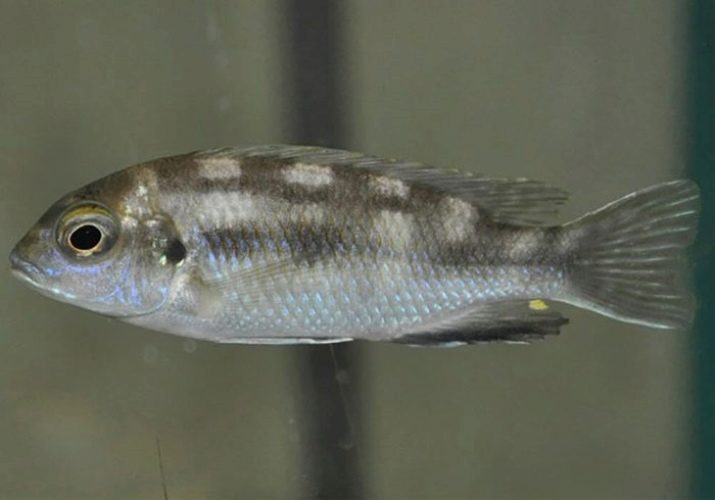
Selection and nuances of care
Whatever variety of pseudotrophies you choose for your aquarium, remember that it is advisable to populate all the fish at the same time so that the "owners" of the aquarium do not begin to oppress the "guests" when dividing the territory. It’s also very important to create the necessary surroundings: plant underwater plants with strong roots and dense leaves, decorate the bottom with clay shards, stones, put “caves” from them, put a couple of snags - all this is necessary for cichlids to rest and hide, how they do it in the wild.
When selecting "neighbors" for pseudotrophies, pay attention to the same size ones - as a rule, they coexist quite well in one territory. If flock formation is recommended, remember that there should be at least 3-4 females per male.
As for the volume of the tank, proceed from the calculation that for 5-6 small fish (up to 10 cm in length) a capacity of 60 liters is required. For larger representatives (10-15 cm) you will have to purchase a 100-liter aquarium.
Although the larger the volume of the aquarium, the better, since your fish can live a fuller life in it, walking around a vast territory.
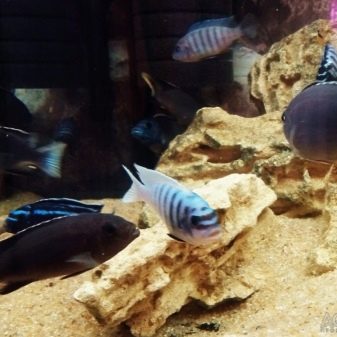
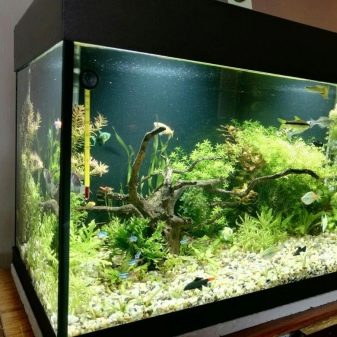
Any cyclic demanding water quality. Its temperature should be kept at 26 to 29 degrees, pH - from 7.2 to 8.5 units, dH - 4-20 °. Be sure to install and configure a filtration and aeration system. Approximately 30% of the water in the aquarium can be updated weekly. - it will be more convenient for you and the fish than a full update once a month.
As for the feed - most of the pseudotrophyus are herbivorous, they gladly eat salad and nettle leaves, dandelion tops, spirulina and other algae. They also need protein - Daphnia, cyclops, brine shrimp can become its source. Young growth is allowed to feed bread crumbs (it is advisable to take varieties of bread such as "Borodinsky" or "Capital").
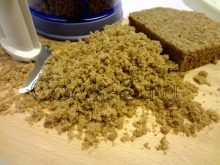

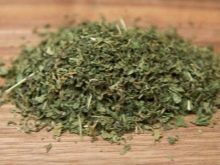
Propagation Features
Pseudotrophies reach sexual maturity at about 9-12 months. During the mating season, the female throws eggs on the ground or a flat stone, the male fertilizes it, after which the female collects eggs and carries them in her mouth. The incubation period is from 2 to 4 weeks, all this time the expectant mother “fasts”.
It is recommended that the female with caviar be transplanted into a separate container so that she does not have to defend herself against the attacks of her “neighbors” and relatives. After the birth of young animals, they can be transplanted back.
About zebra pseudotrophyus care features see below.
